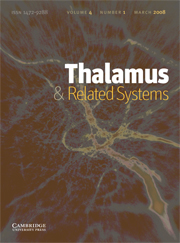Article contents
Early activation of cyclic AMP response element binding protein (CREB) following loose ligation of the sciatic nerve in rats
Published online by Cambridge University Press: 11 October 2005
Abstract
Activation of cyclic AMP response element-binding protein (CREB) in the spinal dorsal horn may be a crucial contributor to the activity-dependent synaptic plasticity that is thought to underlie the development of persistent pain following peripheral nerve injury. In this study, we examined the early period of CREB activation following chronic constriction injury (loose ligation) of the sciatic nerve in rats. The estimated levels of Ser133-phosphorylated (activated) CREB significantly increased at 2 hours (424 ± 85%) and remained elevated at 4 hours (349 ± 97%) and 8 hours (258 ± 69%) after sciatic ligation compared with control animals. By contrast, activated CREB levels in sham-operated animals were not significantly greater than in control animals except at 1 hour (176 ± 6%) and 8 hours (288 ± 16%). The maximal ligation-associated activation of CREB at 2 hours occurred bilaterally and was dependent, at least partly, on NMDA-receptor activation because pretreatment with 20 µg MK-801 significantly attenuated the ligation-associated activation of CREB. The levels of non-phosphorylated CREB in ligated and sham-operated animals did not differ significantly from controls at the time-points examined.
These data establish a significant, persistent increase in CREB phosphorylation within hours of loose ligation of the sciatic nerve and indicate an early but consequential injury-related shift in the manner in which spinal dorsal horn neurons processed sensory information. The data lend further support to the notion that ligation-associated CREB-dependent synaptic plasticity in the spinal dorsal horn might underlie the development of persistent pain following peripheral nerve injury.
Information
- Type
- Research Article
- Information
- Copyright
- © 2005 Cambridge University Press
- 1
- Cited by

